Note: This review will involve a lot of spoilers for any game with “NieR” in the title. It’s unfortunately inevitable, and if you’d like to go into the franchise “clean”, I would recommend avoiding this article until you’ve completed both games. Or don’t, and realize why you should finish both games. Regardless, you’ve been warned.
Today’s game is NieR: Automata, the sequel to NieR: Gestalt. Both of these games are emblazoned with this lovely little logo:

This is appropriate, as Yoko Taro has somehow been responsible for the most emotionally mature videogames in the medium.
 Mind you, that is a pretty low bar to clear. As an obvious example, every Grand Theft Auto game has been rated as “Mature”, so Rockstar has taken the “only adults are supposed to play this” mandate to heart and written grandiose, developed stories meant to appeal to an exclusively aged demographic. Ha ha ha, just kidding, Grand Theft Auto games are more about seeing how many times the number 69 can be inserted into random conversations than it is ever about telling a “real” story about violence in America… or whatever they’re shoveling into their press releases this week. And even if you take the GTA series completely seriously, you have to acknowledge that the franchise is fairly limited in perspectives. Would you like to play as the angry white guy, the angry black guy, or the angry and balding white guy? Yes, you could argue this thin characterization is the result of having to present a protagonist that might surf cars and play with a rocket launcher in his (inevitably “his”) spare time, but I know plenty of psychopaths, and they do have a slightly broader emotional range than “always irritated all the time.” People are people, Rockstar, not robot animals.
Mind you, that is a pretty low bar to clear. As an obvious example, every Grand Theft Auto game has been rated as “Mature”, so Rockstar has taken the “only adults are supposed to play this” mandate to heart and written grandiose, developed stories meant to appeal to an exclusively aged demographic. Ha ha ha, just kidding, Grand Theft Auto games are more about seeing how many times the number 69 can be inserted into random conversations than it is ever about telling a “real” story about violence in America… or whatever they’re shoveling into their press releases this week. And even if you take the GTA series completely seriously, you have to acknowledge that the franchise is fairly limited in perspectives. Would you like to play as the angry white guy, the angry black guy, or the angry and balding white guy? Yes, you could argue this thin characterization is the result of having to present a protagonist that might surf cars and play with a rocket launcher in his (inevitably “his”) spare time, but I know plenty of psychopaths, and they do have a slightly broader emotional range than “always irritated all the time.” People are people, Rockstar, not robot animals.
NieR: Gestalt (note: that will be the last time I type “Nier” with correct capitalization) is what could easily be the story of one angry white dude. The titular Nier is a widowed father doing his best to raise his beloved daughter in a post-apocalyptic (though fairly pastoral) countryside that just happens to be overrun by freaky shadow monsters. A little ways through the story, Nier’s cherished and fragile daughter is kidnapped by Shadow Monster Prime, and Nier is forced to embark on a years-long expedition across the world to rescue the poor moppet. Along the way, he loses an eye, gains some friends, and finally violences his way right across Shadow King’s face. This act incidentally dooms the entire human race, but it’s cool, because Angry Dad rescued Precious Daughter, and the player can feel good about being the manliest man that ever manned.
Except, while that description may work for a number of “dad games” (Bioshock Infinite, Last of Us, The Walking Dead), it doesn’t quite describe Nier. Nier does a lot of things you don’t traditionally see from the angry masses of many videogames. For one thing, he’s responsible for one of the most emotionally resonant moments in gaming.
Let’s talk about Emil. Emil is a child. Well, thereabouts, I mean, he is technically immortal and at least centuries old, but he also looks and acts no older than about fourteen. He also has a fairly significant disability: his eyes turn anyone to stone, so he’s forced to wear a blindfold at all times. When this ability simultaneously saves the day and also paralyzes a friend, Nier and Emil venture forth on a quest to gain control over Emil’s peepers. They succeed, but at a terrible cost: Emil can only vanquish his monstrous, skeleton-like sister through a sort of soul-merge fusion thingy. Emil maintains his consciousness through the process, but is left with a body that is a little… unusual.
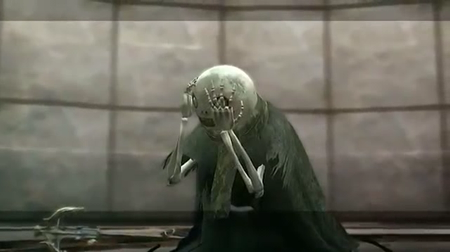
Nier is there for the transformation, and Emil sheepishly weeps at his new form. Nier’s reaction?
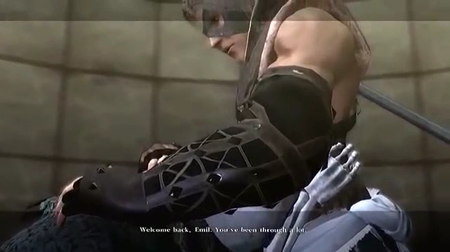
Without saying a word, he embraces the boy, and then tells the kid, “welcome back,” and, “We’re here for you, no matter what.” Yes, Emil is a freaky skeleton creature now, but he’s still Nier’s friend right to the end. This could easily be a scene featuring “Cool Nier” making some flippant comment or acting like it’s no big thing, let’s get moving; but no, we see some genuine paternal affection, and Big Scary Nier is perfectly willing to dispense hugs when necessary. Nier is a badass Cyclops that will beat rampaging boars to death with a spear, but he’s also a man that knows when to be affectionate with his friends. That’s true maturity.
 But today’s game is not NieR: Gestalt, it is its sequel, NieR: Automata (dammit, it happened again). Automata has forsaken Burly Dad Nier, and replaced him with Pretty Lady, Pretty Boy, and Pretty Lady That Could Use a Bath. The main villains are The Pretty Twins, and that majority of the supporting cast could double as Barbie dolls. Once again, superficially, this game seems like many other games. Gestalt was aping the hyper masculine violence-fests of the West, and Automata is wall-to-wall porcelain doll women and bishounen boys. Strap yourselves in, audience, we’re in for another adventure where a lesson is learned through defeating a muscular dude with white hair, and the real treasure was friendship all along. Oh, and it’s a Yoko Taro game, so maybe there’s something in there about videogame violence.
But today’s game is not NieR: Gestalt, it is its sequel, NieR: Automata (dammit, it happened again). Automata has forsaken Burly Dad Nier, and replaced him with Pretty Lady, Pretty Boy, and Pretty Lady That Could Use a Bath. The main villains are The Pretty Twins, and that majority of the supporting cast could double as Barbie dolls. Once again, superficially, this game seems like many other games. Gestalt was aping the hyper masculine violence-fests of the West, and Automata is wall-to-wall porcelain doll women and bishounen boys. Strap yourselves in, audience, we’re in for another adventure where a lesson is learned through defeating a muscular dude with white hair, and the real treasure was friendship all along. Oh, and it’s a Yoko Taro game, so maybe there’s something in there about videogame violence.
But, to say the least, Automata is a little bit more affecting than expected. There are so many moments, so many little things, that I could note here. Maybe I should mention the pacifist that learns to use violence just in time to (not) save his family. Maybe I should illustrate my point with the “spotter” NPCs that outline their hopes and needs through completely incidental dialogue. Maybe I should talk about the twin brothers that wish to be more human, but get into an argument about wearing pants along the way. Oh, wait, did I not mention that the entire cast of Automata is made up of robots? Specifically robots that have likely never even seen a human being? Maybe I should start there, with the creatures that we traditionally portray as wholly emotionless.
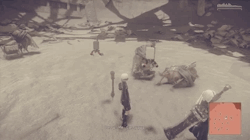 The robot trope of “what is this thing you humans call… love” has been around forever, and was likely most popularized by
The robot trope of “what is this thing you humans call… love” has been around forever, and was likely most popularized by Arnold Schwarzenegger Data of Star Trek. Silly robots can’t feel anything, so they spend all their time trying to feel something, because that’s what true consciousness is, blah blah blah, we all learn a valuable lesson about friendship (again). Automata indulges in this trope, too, but it leaves out one important part: the humans. There are no humans in Automata at all, as they are all living on the moon with their girlfriend from Canada (you wouldn’t know her). This leaves the androids and machines to sift through the ruins of human civilization in a desperate attempt to figure out what came before. Despite the fact that androids and machines are on opposite sides of a seemingly endless war, they both spend a lot of time emulating humanity, and participating in random activities that they hope will get them closer to an unseen, uncaring, and seemingly absent entity. Androids were clearly modeled after humans, and machines were incidentally modeled after (previously mostly human) Emil, and they know they were modeled in someone’s image, so why not try to be more like that blessed likeness? Ha ha, silly androids and machines, always fighting over nothing. You’re both equally meaningless mechanical creatures! Get over yourselves! Stop worshipping at the altar of the beings you believe created you, stop arguing all the time, and just work together. Can’t you be more like us humans, and… Oh… Wait… We spend all our time fighting our equals and arguing over our creators (maybe with a capital C), too, don’t we? Damn. Maybe you bots should stop being like humanity…
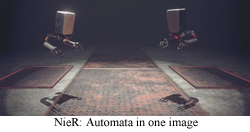 But while it’s easy to see the moral of Automata’s story (something about life being goddamned embarrassing, I think), to really see the difference between Automata’s maturity and practically the whole breadth of videogames, you need look no further than one of the game’s protagonists, 2-B. Once again, we have a character that superficially appears to be nothing more than a general anime trope: 2-B is a “strong female character”. She also has a boy in her life, and, while she maintains an emotional distance, she clearly likes the boy, and occasionally lets the light of her affection shine through the cracks. In short, she could be described as the tsundere archetype. Hey, boy sidekick, I just saved your life, but it’s not because I like you or anything. Couple this with her inclination towards dressing like something out of a Marvelous jaunt, and it would be very easy to label 2-B as another videogame protagonist that conveniently doubles as a fetish for the player (the predominantly male demographic of players, incidentally).
But while it’s easy to see the moral of Automata’s story (something about life being goddamned embarrassing, I think), to really see the difference between Automata’s maturity and practically the whole breadth of videogames, you need look no further than one of the game’s protagonists, 2-B. Once again, we have a character that superficially appears to be nothing more than a general anime trope: 2-B is a “strong female character”. She also has a boy in her life, and, while she maintains an emotional distance, she clearly likes the boy, and occasionally lets the light of her affection shine through the cracks. In short, she could be described as the tsundere archetype. Hey, boy sidekick, I just saved your life, but it’s not because I like you or anything. Couple this with her inclination towards dressing like something out of a Marvelous jaunt, and it would be very easy to label 2-B as another videogame protagonist that conveniently doubles as a fetish for the player (the predominantly male demographic of players, incidentally).
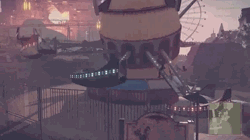 But 2-B asserts herself in ways that completely deny any attempts to reduce her to an object. Yes, her feelings for companion, 9-S, may be interpreted as “tsundere”, but she got to this point because of a backstory that is gradually doled out right up to the finale, and, suffice it to say, it’s a lot more complicated than hoping senpai will notice her (though I suppose she’s more the senpai here). 2-B starts as a typical sexy blank slate archetype, but gradually becomes her own person, and even emphasizes her self-determination well after she’s dead. 2-B winds up as a sort of ghost in a(nother) machine, and even as nothing more than an “influence” on another character, she’s omnipresent. Everything that happens during the finale of Automata is the end result of 2-B’s wants and desires, and that’s pretty impressive considering it involves interplanetary travel and a couple of droids attempting to salvage what’s left of the human race. 2-B is a strong female character, but, more than that, she’s the driving force of her universe. Heck, she’s carrying the weight of the world.
But 2-B asserts herself in ways that completely deny any attempts to reduce her to an object. Yes, her feelings for companion, 9-S, may be interpreted as “tsundere”, but she got to this point because of a backstory that is gradually doled out right up to the finale, and, suffice it to say, it’s a lot more complicated than hoping senpai will notice her (though I suppose she’s more the senpai here). 2-B starts as a typical sexy blank slate archetype, but gradually becomes her own person, and even emphasizes her self-determination well after she’s dead. 2-B winds up as a sort of ghost in a(nother) machine, and even as nothing more than an “influence” on another character, she’s omnipresent. Everything that happens during the finale of Automata is the end result of 2-B’s wants and desires, and that’s pretty impressive considering it involves interplanetary travel and a couple of droids attempting to salvage what’s left of the human race. 2-B is a strong female character, but, more than that, she’s the driving force of her universe. Heck, she’s carrying the weight of the world.
And that’s why Yoko Taro is responsible for the most emotionally mature videogames available. NieR: Automata (argh!) does not feature walking fetishes or basic archetypes, it features people. Even when they’re robots, Yoko Taro’s games are about humans, and what it means to be human. These are not simple macho fantasies about murder-based universes, these are stories about real, artificial people. And, what’s more, these games seem to accomplish this without even trying. Then again, I’m pretty sure the guy has a good idea of what he’s doing…
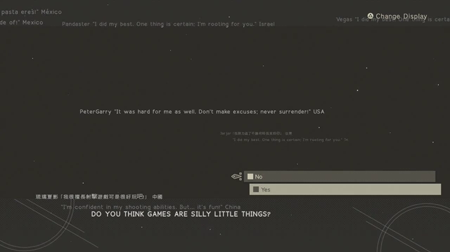
After the whole of Automata, I never answered “No” so quickly in my life.
FGC #303 NieR: Automata
- System: Playstation 4 and PC. I guess the Xbone isn’t worthy.
- Number of players: Wouldn’t it be cool if a second player could control a revived alterna-corpse? Oh well, maybe next time.
- What’s the difference between NieR and Drakengard, anyway? In Drakengard, every character, protagonists included, is worthy of death. In NieR, every character, villains included, is worthy of life. Simple distinction.
- Favorite Moment in Any Videogame Ever: These robots are too stupid to figure out how to make a robot grow up.
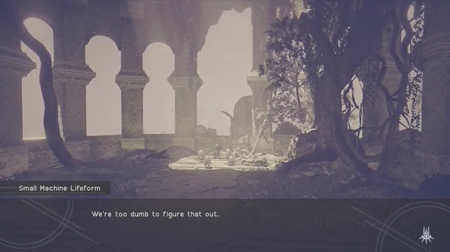
I will never stop laughing at the entirety of this scene. I refuse to explain exactly why.
- Speaking of Emil: Emil winds up being the only 100% confirmed returning NieR character, and he’s also responsible for an emotional gut punch that hits like Zangief. But that’s all inconsequential, because he starts his own mobile shop and zooms around blasting his own personal theme music. Emil has really made something of himself in the last few millennia.
- Platinum Trophy: Unlike NieR: Gestalt, Automata’s gameplay is primarily provided by Platinum, which means the combat actually has some weight to it. Or it just means that dodging is the most important thing you can ever do. Hey, at least you don’t have to dodge lightning to open any doors. That said, could Sega hurry up and let Platinum make a new Space Harrier/After Burner game? Because I am tired of it being wedged into every game they make.
- Did you know? There are currently 634,216 topics on the Gamefaqs message board for NieR: Automata regarding 2-B’s ass. Okay, that number might not be accurate, but it’s pretty close.
- Would I play again: Yes. After all, I might be kissing my save file good-bye in the near future…
What’s next? Random ROB has chosen… Pokémon X! Geez, talk about tonal whiplash. Now it’s time to deal with a different kind of adorable monster. Please look forward to it!
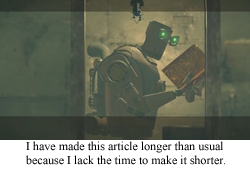
[…] about the game for a second: I feel like I talked about the emotional impact of NieR enough during the Automata review, and the plot is covered enough up top, so I’ll just go ahead and say it: I prefer the gameplay […]
[…] running. No matter, my only concern right now is whether I should name my long-haired, super bulky YoRaHa android “Chub-B” or […]
[…] to a 3-D bullet hell involving extremely short skirts and literal panty shots. (…. No, it’s not Nier Automata, that is a completely different situation.) And, yes, you are pixie sized, so all the NPC women are […]
[…] And it could have happened to videogames, too! Actually, it absolutely did. Thanks to ESRB regulations and conservative retailers, videogames were not sold in many brick and mortar stores if they ranked as an “Adults Only” title. And considering that physical stores were all that existed for a long time, we didn’t see anything that could even prod at that AO rating until three console generations later. And while no one is exactly lamenting a lack of Senran Kagura on the Super Nintendo, it is hard to say if something like the entire Suda51 or Yoko Taro oeuvre would have been allowed in the wake of 1990s videogame panic. Love ‘em or hate ‘em, gaming needs more voices in its chorus, and we would be missing out on some very distinct tones if we universally outlawed android butts. […]
[…] Now we have games with super violent, sexy robots twirling about with swords but also taking the time to acknowledge the emotional needs of their buddies. We have the hyper violent franchises where things might be horrible all over the place, but at […]
[…] Do you understand how much of the Persona 5 soundtrack has been playing in my head since April? NieR: Automata also wound up on that mental playlist, and those phat beats were somehow attached to a game that […]